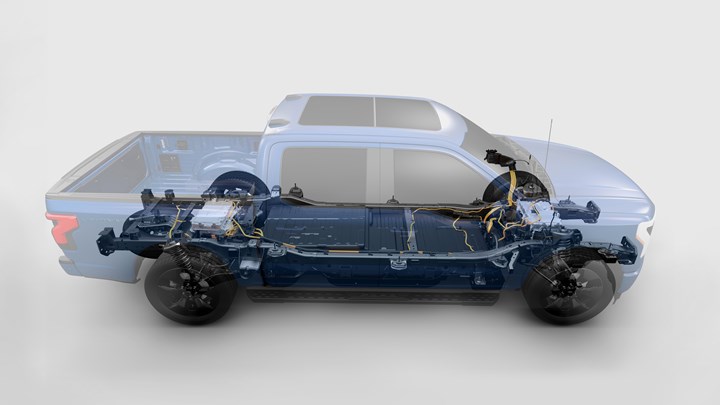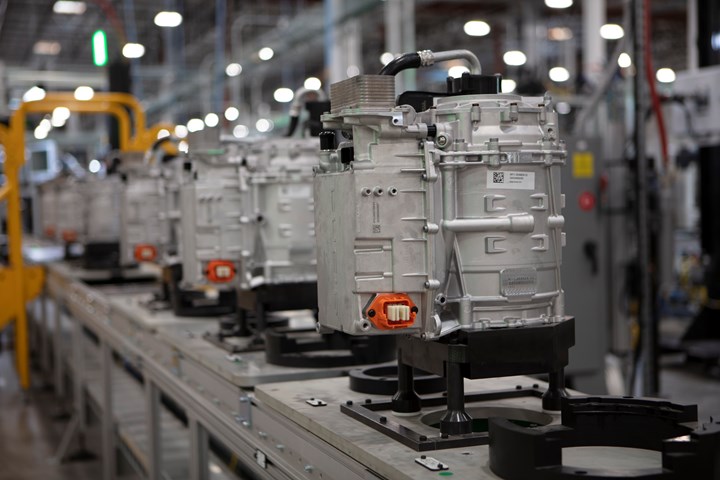On Fuel Cells, Battery Enclosures, and Lucid Air
A skateboard for fuel cells, building a better battery enclosure, what ADAS does, a big engine for boats, the curious case of lean production, what drivers think, and why Lucid is remarkable
This week On Automotive
- Hydrogen-Powered Skateboard for Trucks
- How the F-150 Lightning Battery Enclosure Is Assembled
- The Cost-Risk ADAS Relationship
- Cue the “Miami Vice” Theme
- What About Lean?
- 3M Finds Drivers Concerned
- A Look at Lucid
///
Hydrogen-Powered Skateboard for Trucks

This hydrogen-powered truck will take part in the ‘22 Dakar Rally. (Image: Gaussin)
You’ve undoubtedly heard of the “skateboard” architecture that is the underpinning for electric vehicles, where the battery, motor and chassis are integrated into a slab with wheels upon which the cabin and associated components are attached.
Gaussin, a French engineering company, announced earlier this year that it had developed a skateboard not for sports cars or sport utes but for trucks, including Class 8 tractors.
And while the other skateboards are for battery electric vehicles, the Gaussin skateboard is for hydrogen or electric powertrains.
When it revealed the skateboards—it worked with Magna on developing the chassis, which it says weights 400 kg less than competitive chassis on the market—it differentiated the two:
- Long-distance. This is the hydrogen version. A 20-minute refueling provides a range of 800 km
- Short-distance. Electric. A three-minute battery swap is good for 400 km.
The skateboard is scalable, with a wheelbase ranging from 3,800 to 6,000 mm.
The skateboard is one thing.
The rest of the truck is another.
So Gaussin engaged Pininfarina to design the trucks. There are five variants:
- Road tractor
- Autonomous
- Distribution
- Construction
- Racing
The first: the H2 Racing Truck.
It features:
- Two 300-kW e-motors
- 380 kW of fuel cells
- 82 kWh of batteries
- 80 kg of hydrogen
The H2 Racing Truck will be entered into the 2022 Dakar Rally.
The data collected during the race will be used to develop the other four trucks in the lineup.
The race will certainly put the truck to the test. It is being run in Saudi Arabia, starting on January 1 in Ha’l and finishing, two weeks later, in Jeddah. The route includes a run through the Empty Quarter, which the race organizers describe as being “as sandy as it is mysterious.”
Presumably if the H2 Racing Truck can deal with the heat and sand of the desert, it can make a run on the highways of the world.
///
How the F-150 Lightning Battery Enclosure Is Assembled

The battery enclosure for the F-150 Lightning is a welded aluminum assembly. (Image: Magna)
When the Ford F-150 Lightning electric pickup launches next year, it will be fitted with an enclosure for the high-voltage batteries, electronic components, sensors, and connectors that is all-aluminum, consisting of both extrusions and castings.
The enclosure is being produced by Cosma International, the body and chassis group of Magna.
According to Magna, the enclosure is being assembled using both laser hybrid and cold metal transfer (CMT) welding.
Which led us to wonder. . .why?
So we asked.
And learned:
“A standard MIG welding technique uses a lot of energy which generates a lot of heat. Using MIG welding on an assembly as large as the F-150 battery tray would result in a lot of distortion.
“We use hybrid laser welding on the floor of the battery tray since it requires very long, continuous welds. Hybrid laser welding --a combination of laser and arc welding--uses a laser to preheat the area to be welded so arc welding can be done with a lower amount of energy and heat.
“All other welds are made using CMT with pulsed waveform to reduce heat input.”
(CMT, incidentally, is a modified MIG welding process that uses a special wire feed system and high-speed digital control such that there is controlled material deposition and low heat input.)
///
The Cost-Risk ADAS Relationship
LexisNexis Risk Solutions uses data and analytics to reduce risk for government agencies and businesses, such as insurance companies. Including those that write vehicle insurance policies.
LexisNexis has recently performed an assessment—based on 11-million randomly selected vehicles from model years 2014 to 2019—to determine the effect of advanced driver assistance systems (ADAS) on insurance claim severity.
That is: doesn’t ADAS make claims more expensive?
According to LexisNexis:
“Combining results of the multivariate frequency and severity analyses shows a 23% reduction in Bodily Injury loss cost, 14% reduction in Property Damage loss cost, and 8% reduction in Collision claim loss cost in ADAS vehicles compared to non-ADAS vehicles that have full statistical claims credibility. These loss cost reductions are based on having any core ADAS feature.”
And that’s its emphasis, not ours.
Another interesting assessment it made:
“It is speculation, but the decrease in severity for liability coverages can be justified by the idea that vehicles with ADAS may collide with less force, resulting in less damage to another vehicle (Property Damage claim) or injury to a third party (Bodily Injury claim).”
Speculation, but as they said it out loud, in effect, it is reasonable.
What do they consider to be “core ADAS features”?
- Adaptive cruise control
- Blind-spot warning
- Blind-spot mitigation
- Driver monitoring
- Forward collision warning
- Forward collision mitigation
- Lane departure warning
- Lane departure mitigation
- Rear collision warning
- Rear collision mitigation
The analysis firms also included another technology, which it found to have an impact on the severity of accidents:
- Adaptive headlights
From a personal point of view, the benefits of ADAS are certainly evident (e.g., who doesn’t want to decrease bodily injury?).
From a professional point of view (i.e., you’re a supplier of ADAS or you’re responsible for ADAS implementation at an OEM), this analysis from LexisNexis certainly seems to make a strong argument for the benefits of ADAS tech.
///
Cue the “Miami Vice” Theme

A 600-hp V12 for your boating enjoyment. (Image: Mercury Marine)
Because large, large-displacement engines are becoming something of a rarity in the world of automobility, when we spotted the alphanumeric “7.2-l, V12, 600-hp” we were intrigued.
But no, this is not a new engine—one that is a CES 2022 Innovation Award honoree, no less—for a performance car.
It is an outboard motor from Mercury Marine.
Plenty of firsts
According to Mercury Marine, the Verado is:
- The world’s first V12 outboard.
- It has the industry’s first integrated automatic transmission.
- It is the first outboard with a steerable gearcase that pivots underwater while the engine’s powerhead stays in a fixed position.
Another cited benefit is fuel economy.
The company ran a comparo between a 43-foot, 22,000-pound dayboat with twin Verado outboards and a setup using three 425-hp outboards from a competitor.
Mercury Marine says that its engines provided 20% fuel economy (it runs on 87 octane) and had better acceleration and top speed.
What’s more, in NVH testing, Mercury Marine says that the engine is 30% quieter than a competitor’s 425-hp outboard.
///
What About Lean?
Although to say “lean manufacturing” nowadays might provoke a yawn—after all, for years companies have been implanting it, right?—a recent survey by Drishti Technologies should cause a look of surprise.
The firm, which uses a combination of AI and computer vision to help improve manual assembly operations, asked what the top three obstacles are to implementing lean at their companies, and here are the results (greater than 100% because of asking for the top three):
- 58%: Lean isn’t well understood or prioritized among the management team
- 57%: The costs of implementing lean principles are too high
- 54%: We have hit the productivity limit of people
- 44%: The benefits of lean aren’t clear
- 42%: We don’t have enough data on our operations
- 42%: Resistance to change
It is worth remembering that the book The Machine That Changed the World, the book about Toyota’s lean production principles that is arguably The Book That Changed the World (at least for more than a few years it was a common site in the offices of execs), was published in 1991.
And there are still those who are unfamiliar with lean?
///
3M Finds Drivers Concerned

3M finds drivers concerned as they take to the roads. (Image: 3M)
During the next six months, 47% of respondents to a survey sponsored by 3M say they will travel for a vacation or other reason.
That’s the positive news.
But then. . .
- 53% are concerned about the safety of transportation and roadways when traveling outside their communities
- 35% have a family member or close friend who has died or been seriously injured in a car crash (and of those incidents, almost a third occurred during the pandemic)
- 40% of the 18- to 34-year-olds surveyed said a family member or close friend died or was seriously injured in a traffic accident (nearly half during the past 18 months)
- 35% said they believe transportation has become more dangers due to the pandemic
- 58% said they are driving more carefully since the start of the pandemic
As for what the surveyed said they’re concerned about:
- 83% said other drivers texting or talking on the phone
- 82% negligence of other drivers
- 77% bad weather
- 71% night visibility
- 68% traffic congestion
Why, you might wonder, is 3M interested in this?
The 3M Transportation Safety Division, some 80 years ago, invented the reflective sheeting that is used for reflective road signs.
///
A Look at Lucid

Motors being built by Lucid. (Image: Lucid Motors)
That photo above is of a line of motors for the Lucid Air.
Lucid Motors builds its own motors. Its own batteries. And its own cars.
To provide some dimensional context for the motor, it is small enough to fit into an airplane carry-on. (Although you’d have a tough time getting it into the overhead bin, as it weighs 163 pounds.)
That motor generates 670 hp.
There are two of them—one in the front, one in the rear—of the Lucid Air Dream Edition Performance.
The combo provides 1,111 hp.
A 0 to 60 time of 2.5 seconds.
The thing about the Lucid Air (the variants that will be rolled out in time are the Air Pure, 480 hp; Air Touring, 620 hp; Air Grand Touring, 800 hp; Air Dream Edition Range, 933 hp, and the aforementioned) is that while it has flabergastingly fast acceleration, it is a luxury car. Plush. Comfortable. But the chassis is setup such that it tracks, doesn’t wallow.
The design is sleek (figuratively and literally: the coefficient of drag is just 0.21). The interior is sumptuous in the context of a contemporary vehicle (no, not velour-garish). And although it has to-the-moment technology, there is not a screen the likes of which you might wonder if would fit on the wall of your media room dominating the IP but a 34-inch display that is part of the visual sweep in the cabin. And there are even some—wait for it—buttons.
The range of the Air is 520 miles. With fast charging, in 20 minutes 300 miles can be attained.
I recently had the opportunity to drive the Air.
It is hard to believe that this is the first car built by the company. Its factory is in Casa Grande, Arizona—not exactly the sort of place you’d associate with automotive assembly. (Remember: the Tesla plant in Fremont, California, used to be a GM assembly plant.)
The usual thing would be to show a picture of the exterior. Or the interior.
But you are likely to readily find them (like here).
I think the motor tells the story of a serious tech company making serious vehicles.
RELATED CONTENT
-
TRW Multi-Axis Acceleration Sensors Developed
Admittedly, this appears to be nothing more than a plastic molded part with an inserted bolt-shaped metal component.
-
Things to Know About Cam Grinding
By James Gaffney, Product Engineer, Precision Grinding and Patrick D. Redington, Manager, Precision Grinding Business Unit, Norton Company (Worcester, MA)
-
Plastics: The Tortoise and the Hare
Plastic may not be in the news as much as some automotive materials these days, but its gram-by-gram assimilation could accelerate dramatically.


.jpg;width=70;height=70;mode=crop)






